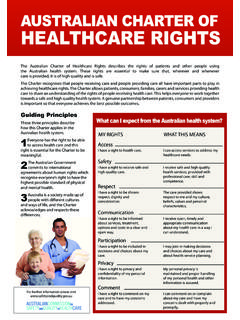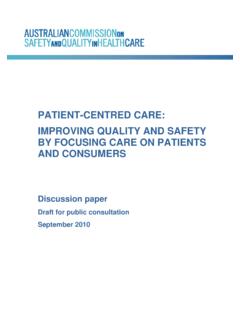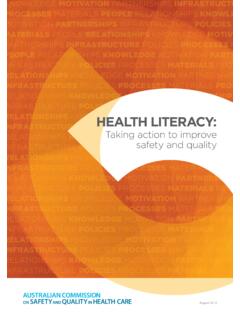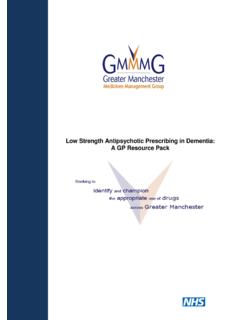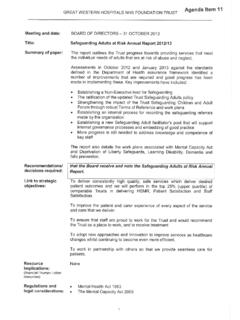Transcription of Indicator Specification – Delirium Clinical Care Standard
1 Indicator Specification Delirium Clinical care Standard July 2016. Commonwealth of Australia 2016. This work is copyright. It may be reproduced in whole or in part for study or training purposes subject to the inclusion of an acknowledgment of the source. Requests and inquiries concerning reproduction and rights for purposes other than those indicated above requires the written permission of the Australian Commission on Safety and Quality in Health care , GPO Box 5480 Sydney NSW 2001 or ISBN: 978-1-925224-07-8. Suggested citation Australian Commission on Safety and Quality in Health care . Indicator Specification : Delirium Clinical care Standard .
2 Sydney: ACSQHC, 2016. Acknowledgments This document has been prepared by Australian Commission on Safety and Quality in Health care . Technical input was provided by Dr Glenn Arendts, Associate Professor Ravi Bhat, Associate Professor Simon Bell, Associate Professor Laurie Grealish, Dr Judy McCrow and Ms Anne Moehead. The Commission gratefully acknowledges the contributions of these experts, members of the Delirium Clinical care Standard Topic Working Group and other key experts in the development of this document. Disclaimer The Australian Commission on Safety and Quality in Health care has produced this Indicator Specification to support monitoring of the corresponding Clinical care Standard .
3 The Indicator Specification and the Clinical care Standard support the delivery of appropriate care for a defined Clinical condition and are based on the best evidence available at the time of development. Healthcare professionals are advised to use Clinical discretion and consideration of the circumstances of the individual patient, in consultation with the patient and/or their carer or guardian when applying information contained within the Clinical care Standard . Consumers should use the information in the Clinical care Standard as a guide to inform discussions with their healthcare professional about the applicability of the Clinical care Standard to their individual condition.
4 Contents Introduction 4. Scope and definition of Delirium used for this Indicator Specification and data sources 7. Guide for use of these indicators 8. Quality statement 1 Early screening 9. Indicator 1a: Evidence of local arrangements for cognitive screening of patients presenting to hospital with one or more key risk factors for Delirium 9. Indicator 1b: Proportion of older patients undergoing cognitive screening within 24 hours of admission to hospital using a validated test 11. Quality statement 2 Assessing for Delirium 13. Indicator 2a: Evidence of training sessions undertaken by staff in the use of a validated diagnostic tool for Delirium 13.
5 Indicator 2b: Proportion of patients who screen positive for cognitive impairment at admission who are assessed for Delirium using a validated diagnostic tool 15. Indicator 2c: Rate of Delirium among acute admitted patients 17. Indicator 2d: Rate of Delirium among acute admitted patients with onset during the hospital stay 19. Quality statement 3 Interventions to prevent Delirium 21. Indicator 3a: Evidence of local arrangements for implementing interventions to prevent Delirium for at risk patients 21. Quality statement 4 Identifying and treating underlying causes 23. Indicator 4a: Proportion of patients with Delirium who have a comprehensive assessment to investigate cause(s) of Delirium 23.
6 Indicator 4b: Proportion of patients with Delirium who receive a set of interventions to treat the causes of Delirium , based on a comprehensive assessment 24. Quality statement 5 Preventing falls and pressure injuries 25. Indicator 5a: Evidence of local arrangements for patients with Delirium to be assessed for risk of falls and pressure injuries 25. Indicator 5b: Proportion of patients with Delirium assessed for risk of falls and pressure injuries 26. Indicator 5c: Proportion of patients with Delirium who have had a fall or a pressure injury during their hospital stay 27. Indicator Specification : Delirium Clinical care Standard , July 2016 1.
7 Quality statement 6 Minimising use of antipsychotic medicines 28. Indicator 6a: Evidence of local arrangements to ensure that patients with Delirium are not routinely prescribed antipsychotic medicines 28. Indicator 6b: Proportion of patients with Delirium prescribed antipsychotic medicines in hospital 29. Quality statement 7 Transition from hospital care 30. Indicator 7a: Proportion of patients with current or resolved Delirium who have an individualised care plan 30. Indicator 7b: Proportion of older patients with current or resolved Delirium who are readmitted for Delirium within 28 days 32. Appendix 1 34. 2 Indicator Specification : Delirium Clinical care Standard , July 2016.
8 Delirium Clinical care Standard 1 Early screening A patient presenting to hospital with one or more key risk factors for Delirium receives cognitive screening using a validated test. In addition, the patient and their carer are asked about any recent changes (within hours or days) in the patient's behaviour or thinking. 2 Assessing for Delirium A patient with cognitive impairment on presentation to hospital, or who has an acute change in behaviour or cognitive function during a hospital stay, is promptly assessed for Delirium by a clinician trained and competent in Delirium diagnosis and in the use of a validated diagnostic tool.
9 The patient and their carer are asked about any recent changes in the patient's behaviour or thinking. The patient's diagnosis is discussed with them and is documented. 3 Interventions to prevent Delirium A patient at risk of Delirium is offered a set of interventions to prevent Delirium and regular monitoring for changes in behaviour, cognition and physical condition. 4 Identifying and treating underlying causes A patient with Delirium is offered a set of interventions to treat the causes of Delirium , based on a comprehensive assessment. 5 Preventing falls and pressure injuries A patient with Delirium receives care based on their risk of falls and pressure injuries.
10 6 Minimising use of antipsychotic medicines Treatment with an antipsychotic medicine is only considered if a patient with Delirium is distressed and the cause of their distress cannot be addressed and non-drug strategies have failed to ease their symptoms. 7 Transition from hospital care Before a patient with current or resolved Delirium leaves hospital, the patient and their carer are involved in the development of an individualised care plan and are provided with information about Delirium . The plan is developed collaboratively with the patient's general practitioner and describes the ongoing care that the patient will require after they leave hospital.



